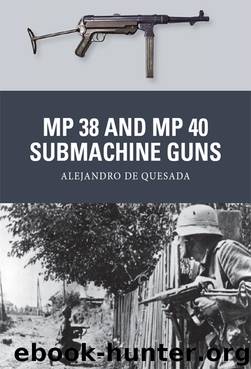MP 38 and MP 40 Submachine Guns by Alejandro de Quesada

Author:Alejandro de Quesada
Language: eng
Format: epub
Tags: MP 38 and MP 40 Submachine Guns
ISBN: 9781780963907
Publisher: Bloomsbury Publishing
This group of German troops in Yugoslavia includes one man armed with an MP 41. (Cody Images)
Members of the Deutsches Afrikakorps armed with MP 38s are seen marching to embark on their transports to fight in Libya. Note the various manners in which the SMGs were carried. (AdeQ Historical Archives)
What is especially revealing is the changing nature of MP 40 distribution amongst the squad as the war went on. The German invasion of the Soviet Union in 1941 forced the Germans to confront the threat of an army heavily armed with SMGs, particularly once distribution of the PPSh-41 and PPS-43 became very widespread from 1942 and 1943. German forces were stunned at the massive volumes of firepower the Soviets could generate during infantry engagements, not least because the ubiquitous PPSh-41 had a 900rds/min rate of fire. This experience informed a significant change in German divisional organization in October 1943, which had an impact on the squad composition. The ten-man squad was reduced to nine men, but the weapons carried by the squad were six rifles, two SMGs, a machine gun and a pistol. Here we note that despite the drop of one man from the squad, the firepower of the unit has significantly increased with the addition of another SMG. The change also reflects the fact that many of the engagements the Germans were fighting were at close ranges, fought in the cities of Ukraine and Russia, or the mountainous terrain of Italy and the Balkans.
In late 1944 and 1945, the movement towards automatic weapons at the squad level intensified further. One advantage of SMGs is that they take less time to train someone in their effective use when compared to a bolt-action rifle. (A precision rifle shot takes sophisticated control of breathing and body mechanics, whereas an SMG requires less sophisticated handling.) Germany was starting to scrape the bottom of the manpower barrel by this time, so any weapon that could reduce training times was welcomed. Furthermore, the battles were pushing through the major cities of Western and Eastern Europe, and the SMG was king in the close-range urban duel. The urgencies of the late-war period produced a further change in squad organization, as historian Stephen Bull here describes:
The Volksgrenadier divisions of late 1944 were effectively ordinary infantry divisions following rebuilding and re-organization. In these, although there were still nine men to a squad, these were either ‘rifle’ or sub-machine gun squads. In the rifle squads the armament stayed the same as previously, while SMG squads were supposed to be armed entirely with that weapon. The exception to the rule was to be the one squad within each ‘SMG’ platoon which carried three rifles and five SMGs in addition to the LMG and pistol; presumably the idea was to give the SMG units some longer-range firepower, but shortage of automatic weapons may also have played a part. (Bull 2004: 24)
The shift towards SMG firepower here described by Bull reflects substantially the Soviet practice of arming entire units purely with SMGs.
Download
This site does not store any files on its server. We only index and link to content provided by other sites. Please contact the content providers to delete copyright contents if any and email us, we'll remove relevant links or contents immediately.
| Automotive | Engineering |
| Transportation |
Whiskies Galore by Ian Buxton(41937)
Introduction to Aircraft Design (Cambridge Aerospace Series) by John P. Fielding(33092)
Small Unmanned Fixed-wing Aircraft Design by Andrew J. Keane Andras Sobester James P. Scanlan & András Sóbester & James P. Scanlan(32764)
Craft Beer for the Homebrewer by Michael Agnew(18196)
Turbulence by E. J. Noyes(7977)
The Complete Stick Figure Physics Tutorials by Allen Sarah(7338)
Kaplan MCAT General Chemistry Review by Kaplan(6899)
The Thirst by Nesbo Jo(6877)
Bad Blood by John Carreyrou(6581)
Modelling of Convective Heat and Mass Transfer in Rotating Flows by Igor V. Shevchuk(6406)
Learning SQL by Alan Beaulieu(6237)
Weapons of Math Destruction by Cathy O'Neil(6214)
Man-made Catastrophes and Risk Information Concealment by Dmitry Chernov & Didier Sornette(5956)
Digital Minimalism by Cal Newport;(5704)
Life 3.0: Being Human in the Age of Artificial Intelligence by Tegmark Max(5514)
iGen by Jean M. Twenge(5385)
Secrets of Antigravity Propulsion: Tesla, UFOs, and Classified Aerospace Technology by Ph.D. Paul A. Laviolette(5333)
Design of Trajectory Optimization Approach for Space Maneuver Vehicle Skip Entry Problems by Runqi Chai & Al Savvaris & Antonios Tsourdos & Senchun Chai(5037)
Pale Blue Dot by Carl Sagan(4953)
